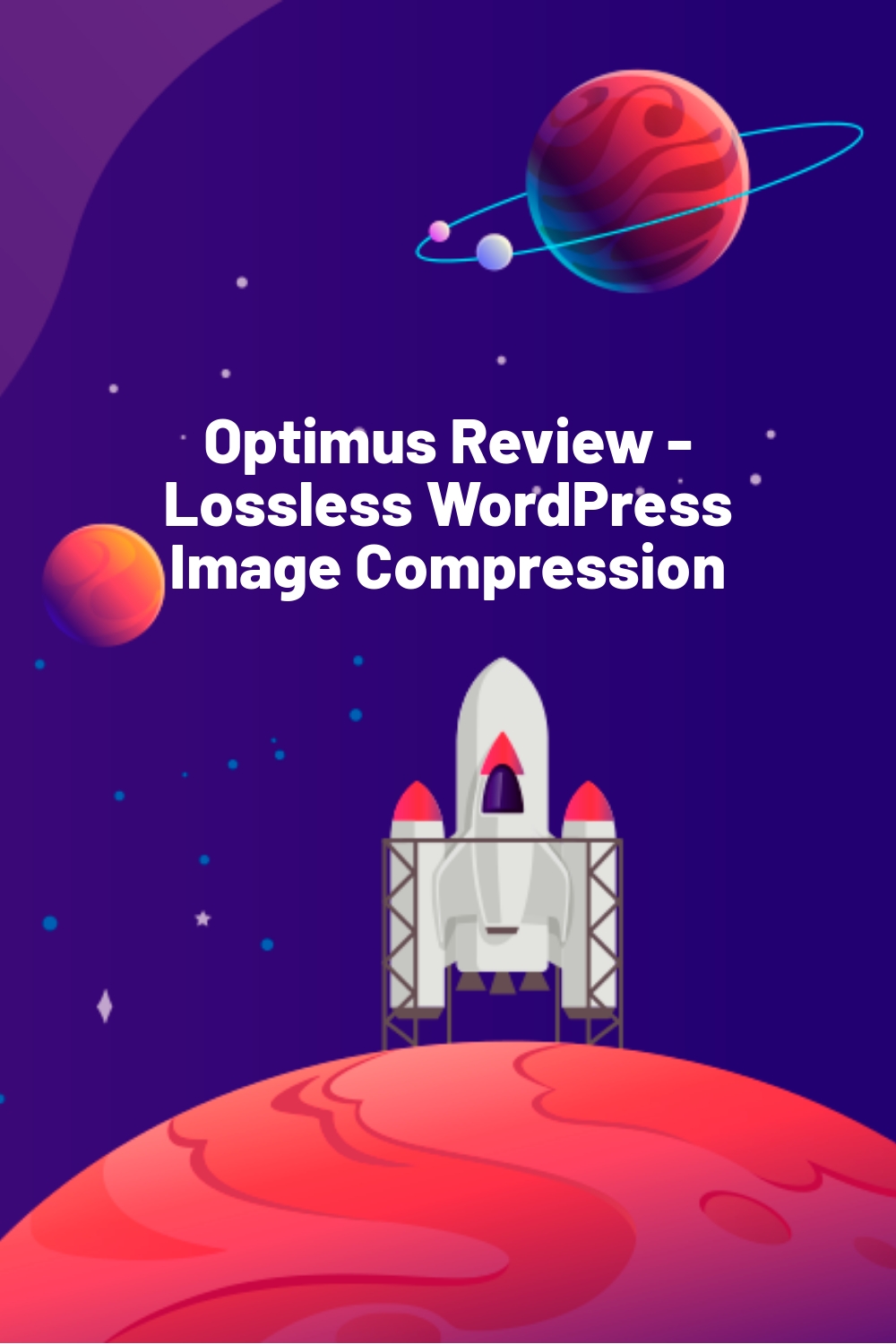WPLift is supported by its audience. When you purchase through links on our site, we may earn an affiliate commission.
Optimus Review – Lossless WordPress Image Compression
Of the twenty web performance experts who KeyCDN interviewed, nine said that image optimization was their number one priority or focus. With results like that, it’s easy to see why KeyCDN decided to create the Optimus plugin.
Optimus is a freemium image optimizer with a bunch of cool features like lossless image compression, WebP conversion, progressive JPEGs, and bulk image optimization.
It’s made by KeyCDN, who obviously know a few things about optimizing performance. They’ve been helping webmasters optimize performance since 2012. If you’re not familiar with their CDN service, we wrote a KeyCDN review all the way back in 2014.
Now back to Optimus…
If you’ve ever run your site through Google PageSpeed Insights, you’ve probably noticed it always tells you to optimize your images:

Why? Because optimized images mean faster page load times. And faster page load times mean better user experience, higher conversion rates, and better search rankings.
Optimus is a powerful tool that can help you optimize your performance by doing a great job at losslessly compressing your images.
Let’s take a look at the plugin…
Optimus Features
Below are the most distinctive features of the Optimus plugin.

Article Continues Below
Lossless image compression
There are two types of image compression:
- Lossy – in lossy compression, some data from the original file is lost during compression. This means that you can drastically reduce the file size, but at the cost of noticeably losing image quality.
- Lossless – in lossless compression, images are compressed by only removing unnecessary data. This means that, while the size reductions won’t be quite as big, the images don’t lose any quality.
Optimus utilizes lossless compression. That means you can still get size reductions of up to 70% without losing any quality. In my testing, I noticed that my unoptimized .PNG files were usually reduced by about 40%, which is pretty good in my opinion.
WebP Conversion
WebP is a new image format spearheaded by Google that provides both lossy and lossless compression. WebP images are 26% smaller than .PNGs and 25-34% smaller than .JPEGs.
Optimus allows you to take advantage of this format by automatically serving WebP images instead of .PNGs or .JPEGs. All you need to do is add the code they provide to your .htaccess file to automatically take advantage of the conversion.
This feature is pretty unique among image optimization plugins.
Because it hasn’t been fully adopted, only users with Chrome or Opera (or other Chromium browsers) can take advantage of WebP images. That means only about 60% of your users can take advantage of WebP.
Progressive JPEGs
Optimus allows you to load JPEGs progressively instead of baseline. What’s the difference? This:

Source: Six Revisions’ JPEG 101: A Crash Course Guide on JPEG
Normally, JPEGs load top-to-bottom. That means that users might have to wait while the image slowly grows.
With progressive JPEGs, the full image is displayed right away. It just takes time for the full quality to load. This is better user experience, because users still get to see the full image right away, even if it is a bit pixelated.
Bulk Optimization
Does your site already have hundreds of images? Optimus includes a bulk optimizer tool that lets you automatically optimize all your current images with the click of a button. This means the plugin can work great on both new and existing sites.
Setting Up the Optimus Plugin
To get started, you install the plugin from the WordPress repository like normal. They give you this notice after activation, which is a nice touch:

Because KeyCDN was kind enough to provide me with a license key for Optimus HQ (the paid version of the plugin), I’ll enter my license key:

Then go to the plugin settings page to see what all I can configure:

Here are the configuration options:
Original Images: Choose whether or not you want Optimus to keep the original version of your image (or only the optimized versions). I keep my original files local, so I’m fine with Optimus only keeping the optimized versions.
Image Metadata: You can have Optimus keep image metadata, at the expense of giving up a little size reduction. I don’t need this so I’ll leave it unchecked. This is only for HQ users.
WebP Files: This is where you can enable the WebP images I discussed above. It’s only for HQ users and you need to add some rules to your .htaccess file to complete the configuration.
HTTPS Connection: For HQ users, you can send images to Optimus’ servers via HTTPS for better security.
Optimize During Upload: You can choose whether or not you want Optimus to automatically optimize images during the upload process. If it were my own site, I would leave this option on for ease of use. But for now, I’ll turn it off so I can show you how to manually optimize images.
That’s it for settings, but before I show you how to use the plugin, I want to cover one more thing…
Where Does Optimus Optimize Images?
Rather than optimizing images on your local server, Optimus sends images to the Optimus server for optimization.
I’m not sure there are major privacy concerns with this, because you’re presumably planning to share the image publicly anyway.
But, if you are worried about privacy, Optimus doesn’t store any images on their server. They immediately delete images after optimization.
Using the Optimus Plugin
As I mentioned, I turned automatic optimization off. Normally, you could have Optimus do all this automatically on image upload. But here’s how you can manually optimize images or use the bulk image optimizer.
To get started, I’ll upload a nice .JPEG file of a snail race. Then I’ll click the dropdown to find the Optimize images option:

When I click that, it takes me to image optimizer page that shows my progress. Because there was only one image, this didn’t take any time at all:

When I go back to my media library, Optimus shows a clear indication of how much it was able to compress the image:

7%? That’s not anything special. But the image was already fairly optimized. Let’s try it with an unoptimized .PNG file:

40%! That’s much better. I uploaded a bunch more images and the compression seemed to range from 30% to 43%. Optimus claims it can be as high as 70% losslessly, but I imagine the image would have to start incredibly unoptimized to get those results:

You can also always find the Bulk Image Optimizer by going to Tools → Optimize all images:

Then you just need to click one button to optimize all your images:

Optimus vs WP Smush
To get an idea of how Optimus compares to other image optimization plugins, I ran a quick test against WP Smush on two of my localhost sites. I used the same .PNG image with each plugin. Here are the results:

WP Smush reduced the image by 22.1%.
How did Optimus do?

Optimus reduced the same image by 43%.
So, at least with this small sample size, Optimus definitely comes out ahead by a large margin.
Optimus Pricing
The basic Optimus plugin is free. But that comes with some restrictions:
- The max file size is 100KB
- No WebP images
- No HTTPS connection
Personally, the 100KB max file size would be tough for me, so I would probably buy the paid version.
The paid version is called Optimus HQ and costs $19 per year. It gets you:
- 5 MB max file size
- Unlimited use on personal sites (if you’re a developer, they have a license for you, too).
- WebP images
- HTTPS connection
All versions let you optimize unlimited .PNG and .JPEG images, but again, I think the max file size of 100KB on the free version is a good incentive to go paid.
Final Thoughts
Optimus is really easy to use. Basically, all you need to do is install it, enable automatic optimization, and bulk optimize your old images. Then it will just hum along in the background keeping your images optimized.
The WebP option is nice for even bigger compression. I imagine with Google pushing for it, WebP will continue to grow in adoption.
At least in my test, Optimus definitely came out ahead against WP Smush, which is the most popular image optimization plugin as far as I know. Now, my sample size was only one image, but the difference was pretty dramatic. Optimus compressed the image by nearly twice as much.
My verdict? Definitely give Optimus a shot, and get to optimizing those images.











Would be interested to see Optimus tested against Imagify and ImageRecycle.
Will try to give it a shot on my localhost with the same image when I have some time!
Max 100kb is a very low limit to use it as a free plugin. WP Smush does not have that limitation.
I definitely agree it’s limiting! But then again, Optimus did a better job than Smush in my test so it may be worth spending the money to remove that limitation.